


Framed or unframed, desk size to sofa size, printed by us in Arizona and Alabama since 2007. Explore now.
Shorpy is funded by you. Patreon contributors get an ad-free experience.
Learn more.

- Roll your own
- Rugged and real!
- A Charles Purcell - Mama Cass Connection
- Uncle SAAM
- Obfuscation
- One Chocolate Soldier rode away
- Victor Marquis de la Roche
- The Little House Across Way ...
- Vanderbilt Gates
- Vanderbilt Mansion
- You can still see that gate
- Withering heights for me
- So Jim,
- Top Heavy
- Re: Can't Place It.
- Bus ID
- Since you mention it
- The White Pages ?
- Moonlight Tower
- 1907?
- Fire(men) and Water
- Can't Place It
- Can anyone
- Wings
- Where's Claudette and Clark?
- Overbuilt Rolodex
- One song
- Give Me Wings Please!
- PRR
- Pinball Wizards
Printporium
Low Miles: 1942
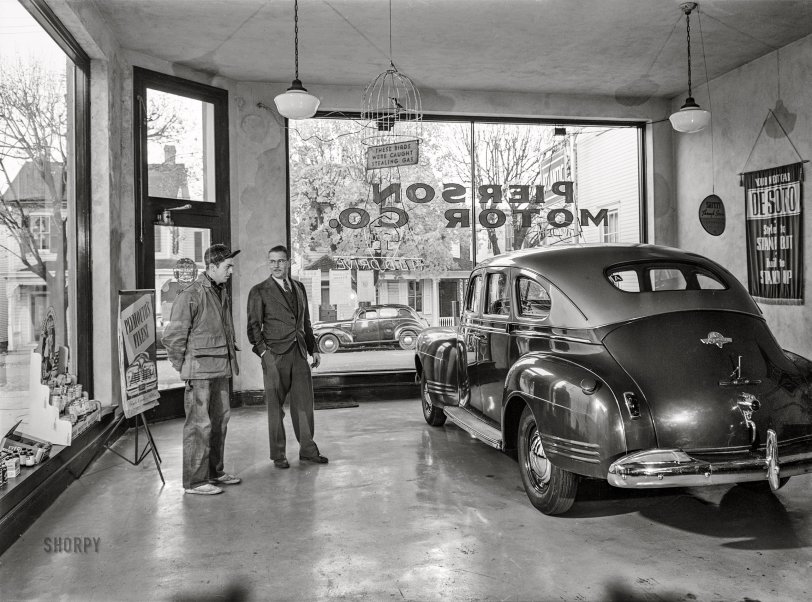
November 1942. "Lititz, Pennsylvania. Showroom of the Pierson Motor Company owned by Al Pierson, who is showing his one second-hand car to a local farmer. Before the war there always were three brand new cars in his showroom. Now the chief business of garages is repairing." Acetate negative by Marjory Collins for the Office of War Information. View full size.
The wall hanging (not the car)
Your next car _ De Soto. Styled to stand out _ Built to stand up!
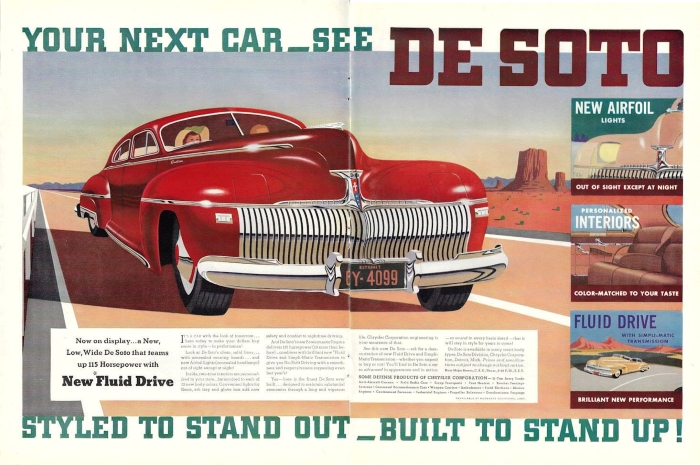
Lively AC
Intrigued by the bird cage with its catchy sign, I did some digging.
An online auction listing for a bird cage similar to this one but plugging (haha) AC spark plugs describes it as a "Vintage Gas Station Display/Sign. Nice early Spark Plugs Display consisting of two old spark plugs posing as birds in a bird cage with a double-sided tin sign hanging underneath that reads: 'These Birds Were Caught Stealing Gas! And replaced with Lively AC spark plugs' The early ones did not have the AC brand on them; they did that later."
So it seems that our sign is one of the early ones without the branding. Now I just wonder why it appears that there is a single stuffed bird in the cage, and not two spark plug birds. Maybe those flew away.
Third brake/tail light
Didn't realize they had that back in the 40's . Thanks !
Reminiscent of 2020-22
The idea of one used car in a dealership is reminiscent of what we saw during Covid, when supply chain was so badly constrained.
I recall showing up at the local Subaru dealer for service and they had absolutely nothing on the showroom floor. No new cars available, and few used.
Re: technique, and paint colors
I googled "1941 Plymouth Special Deluxe Sedan colors" and was surprised to discover how many possible colors this car might have been.
I'm also surprised that no one has commented on the gas thief bird cage.
As for the partially transparent farmer, I think I have a plausible explanation. The most obvious and visible image we see of him is the result of the exposure during the flash. But the film was exposed for a longer duration than that, in order to fully capture the outside elements, and during that time, he moved the parts of his body that appear to be a double exposure (his right arm and the back of his head).
Light and Dark
Seems this image was edited in the darkroom to balance light and dark areas, outdoors and indoors, but not consistently edited. Look out the window on the left, there is a straight vertical strip almost the full height of the window where the house and the trees are all lighter within that strip and darker on both sides outside the strip. Light and dark editing would also explain farmer's transparent effect. Probably not a flash or other artifact, just darkroom work. They could do a lot in the darkroom before Photoshop.
[There was zero editing "in the darkroom." This is a scan of the camera negative. - Dave]
Making ends meet
As GlenJay noted in the first comment below, Mr Pierson was holding down three jobs. But "serving as an air raid warden and aircraft spotter" would seem to be a cosy gig. As we all know, in 1942, swarms of German bombers made repeated non-stop transatlantic return flights of 40 hours in order to disrupt the operations of the Armstrong Cork Company, a key part of the US weapons industry. Seriously, who in government was that far out-of-touch that a ridiculous position of air raid warden and aircraft spotter was funded in nowheresville Pennsylvania?
My dear departed mother was an incendiary bomb rooftop spotter in Oxford, England during the 1940/31 Blitz. For some reason, Germany never bombed Oxford despite the huge Morris Car factory churning out Bren Gun Carriers. But German bombers regularly flew over Oxford on the way to Coventry. Kept her watchful. All Mr Pierson ever had to do besides filling out forms full of zeroes in the Qty columns every day, was to have a darn good sleep every night and collect a paycheck now and then. Truly farcical and illogical to have such official positions, but governments wanted people to be in constant fear of armed alien hordes invading their one-horse towns, apparently. Still at it today.
Seems to be gone
Listed at 28 West Main Street, looks like a new fire department and a parking lot took over as usual.
Future military man
I wonder what would happened to the young farmer. He seems to be of the age the military would mobilize for the war.
Tire treads?
I don’t know anything about tires from this era, but the tire treads look a bit worn to me. Can anyone tell if they were in decent shape? Or during wartime, did we just take what we could get and save the good tires for the war effort?
Brilliant new Plymouth
Information on Plymouth two-tone paint combinations for 1941 is minimal at best. Eye-catching color palette combinations can be visualized in period advertising, links below.
https://vintagepaint.biz/images/source/Chrysler/Plymouth/1941_ply.jpg
https://i.ebayimg.com/images/g/VE4AAOSwSpZd1C7s/s-l1600.png
https://s.car.info/image_files/360/0-940480.jpg
Collins' technique
Okay, there are the shadows from the two flashbulbs -- but why are the farmer's head and right arm transparent, as if she had done open flash?
Reeling him in?
Spiffy salesman appears ready to set the hook and close the deal on an attractive two-tone 1941 Plymouth Special Deluxe Sedan. A 1939 version from the same manufacturer is parked across the street.
I guess the farmer cleaned out the inventory
We can see in the above photo that, in November 1942, Pierson Motor Co. had one used four-door car. But the inventory was triple that in January 1943, as evidenced by the ad below in The Lititz Record-Express. I also learned exploding antifreeze was a thing.
I found the ad looking for an address, which I guess Al Pierson felt wasn't necessary. In another ad the location was listed as Main St. I looked down Main Street on Street View and did not see a building like the one in the 1942 photo.
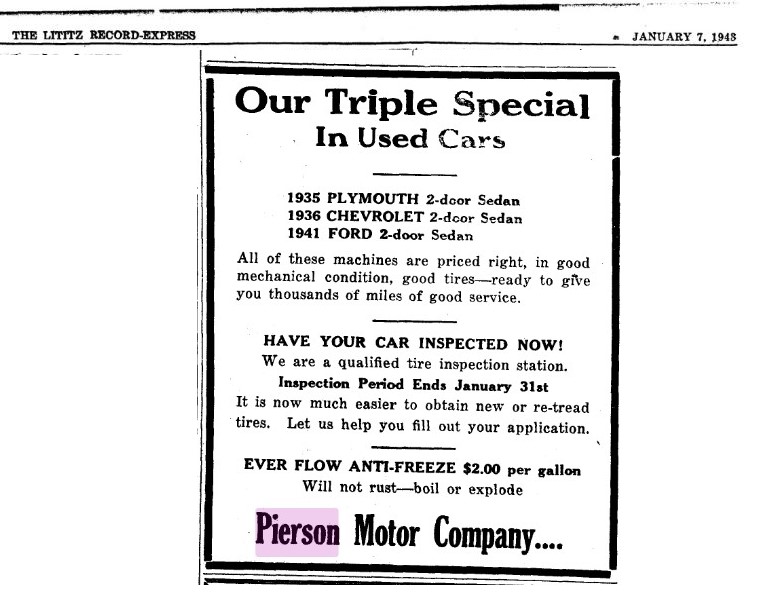
Four Gallons a Week
That "A" gas rationing sticker in the rear window allowed the owner to buy four gallons of gasoline a week. Rationing wasn't done so much to reduce gasoline use as it was done to reduce use of tires and conserve the limited rubber supply.
Of light and color
This is a good example of a photo often seen from this period that shows the position and number of flashes. And it makes me think of how much equipment these photographers were lugging around, and how much effort they had to put into getting the shot. Not to mention knowledge and skill.
Also, the car appears to be two-tone. And I'm sure someone here can tell us what those two colors would have been.
Spiel
"This sweet thing was previously owned by a little old lady, who only drove it once a week to church -- "
Hmmm. Rare photograph
Usually the car salesman has his hand in the customer's pocket.
Al Pierson at war
Marjory Collins also photographed him sitting resignedly at his dealership desk. She reported that, in addition to keeping the garage open, he was working a defense job at Armstrong Cork Company in Lancaster, and serving as an air raid warden and aircraft spotter.
























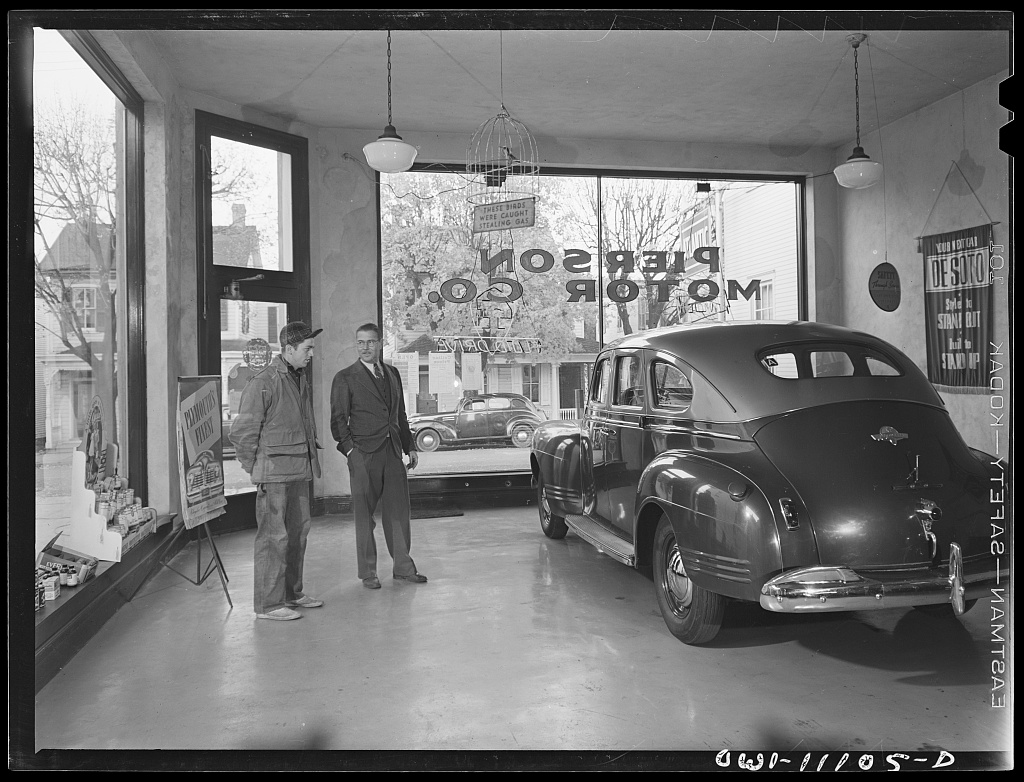
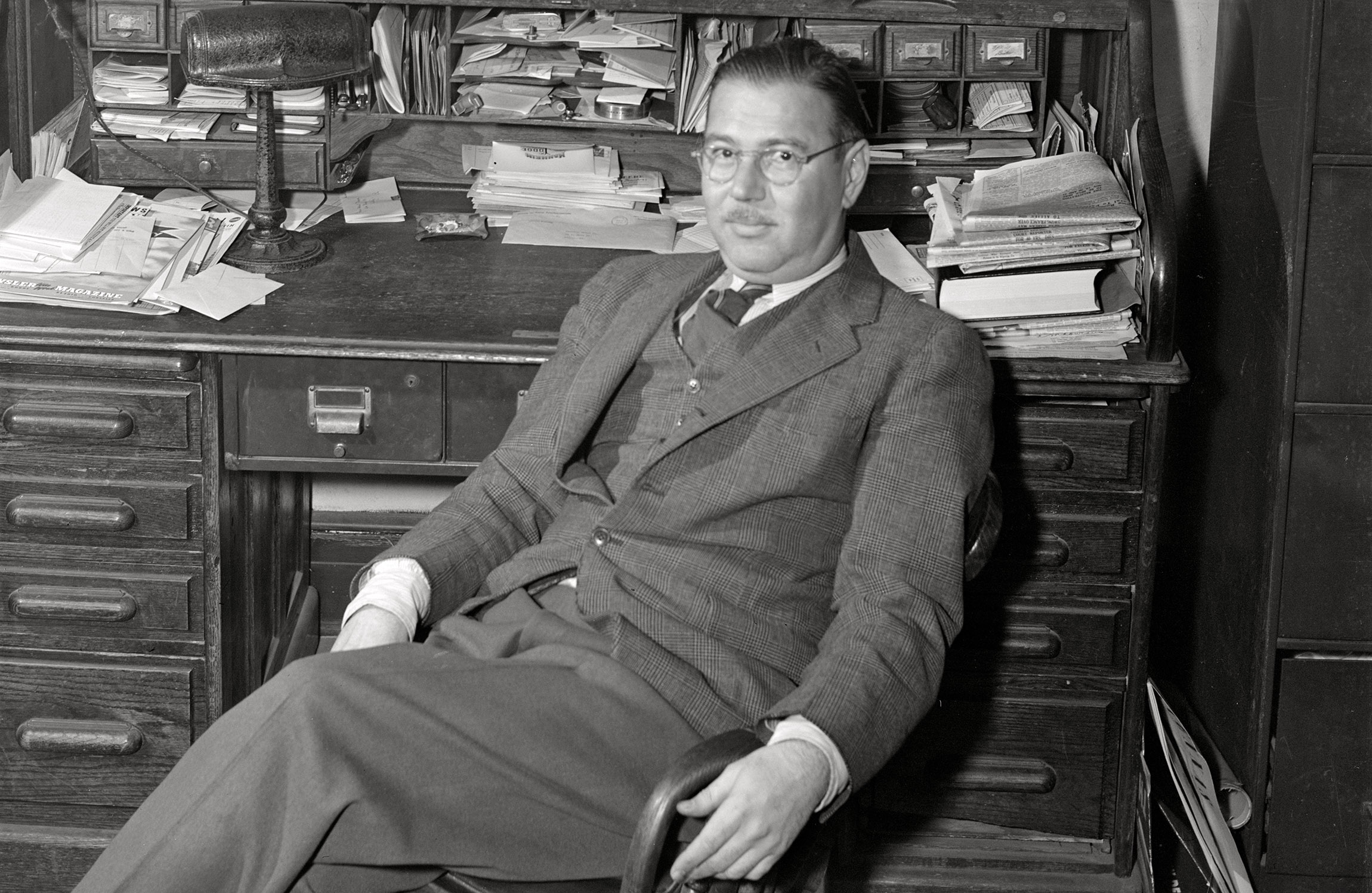
On Shorpy:
Today’s Top 5